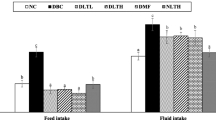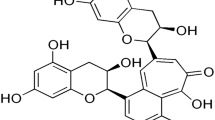Abstract
The present study was aimed to investigate the effect of black tea extract on blood glucose, plasma insulin, Hemoglobin, carbohydrate metabolic enzymes and tricarboxylic enzymes in streptozotocin (STZ) induced diabetic rats. Diabetes was induced in male albino Wistar rats by intraperitoneal administration of STZ (40 mg/kg b wt). Black tea extract was administered to diabetic rats at a dose of 25, 50 and 100 mg/kg body weight for 30 days. The effects of black tea extract on glucose, insulin and HbA1c levels were analyzed to confirm the effective dose. Administration of black tea extract to diabetic rats was significantly decreased the level of glucose, glycated hemoglobin and increased the levels of insulin in a dose dependent manner. The black tea extracts at a dose of 100 mg/kg b wt showed a highly significant effect compared to other two doses (25 and 50 mg/kg b wt). The effect produced by black tea extract (100 mg/kg b wt) was comparable to that of glibenclamide (5 mg/kg b wt) a reference anti diabetic drug. Therefore, 100 mg/kg b wt was fixed as an effective dose and used for further analyses. Black tea extract was administered to diabetic rats at a dose of 100 mg/kg b wt for 30 days reinstated the altered levels of the plasma glucose, insulin, hemoglobin, glycosylated hemoglobin, carbohydrate metabolizing enzymes and tricarboxylic cycle enzymes in diabetic rats. Black tea extract administered to diabetic rats at a dose of 100 mg/kg b wt for 30 days reinstated the altered levels of the plasma glucose, insulin, hemoglobin, glycosylated hemoglobin, carbohydrate metabolizing enzymes and tricarboxylic cycle enzymes in diabetic rats. The effect produced by black tea extract of all the biochemical parameters were comparable with glibenclamide-used as a reference drug.


Similar content being viewed by others
References
American Diabetes Association. Diagnosis and classification of diabetes mellitus. Diabetes Care. 2010;31:S62–9.
Zimmet P, Alberti KG, Shaw J. Global and societal Implications of diabetic epidemic. Nature. 2001;414:782–7.
Moller DE. New drug targets for type 2 diabetes and the metabolic syndrome. Nature. 2001;414:821–7.
Abdul-Ghani MA, DeFronzo RA. Pathogenesis of insulin resistance in skeletal muscle. J Biomed Biotech. 2010;2010:19.
Comerford Kevin B, Pasin Gonca. Emerging evidence for the importance of dietary protein source on glucoregulatory markers and type 2 diabetes: different effects of dairy, meat, fish, egg, and plant protein foods. Nutrients. 2016;8:446.
Sharma VK, Bhattacharya A, Kumar A, Sharma HK. Health benefits of tea consumption. Trop J Pharm Res. 2007;6:785–92.
Gardner EJ, Ruxton CH, Leeds AR. Black tea-helpful or harmful? A review of the evidence. Eur J Clin Nutr. 2007;61:3–18.
Bhattacharya S, Gachhui R, Sil PC. Effect of Kombucha, a fermented black tea in attenuating oxidative stress mediated tissue damage in alloxan induced diabetic rats. Food Chem Toxicol. 2013;60:328–40.
Yang CS, Wang H, Li GX, Yang Z, Guan F, Jin H. Cancer prevention by tea: evidence from laboratory studies. Pharm Res. 2011;64:113–22.
Trinder P. Determination of glucose in blood using glucose oxidase with an alternative oxygen receptor. Ann Clin Biochem. 1969;6:24–7.
Burgi W, Briner M, Franken N, Kessler AC. One step sandwich enzyme immunoassay for insulin using monoclonal antibodies. Clin Biochem. 1988;21:311–4.
Nayak SS, Pattabiraman TN. A new colorimetric method for the estimation of glycosylated hemoglobin. Clin Chem Acta. 1981;109:267–74.
Bannon P. Effect of pH on the elimination of the labile fraction of glycosylated haemoglobin. Clin Chem. 1982;28:2183–4.
Brandstrup N, Kirk JE, Bruni C. The hexokinase and phosphoglucoisomerase activities of aortic and pulmonary artery tissue in individuals of various ages. J Gerontol. 1957;12:166–71.
Koide H, Oda T. Pathological occurrence of glucose-6-phosphatase in serum in liver diseases. Clin Chim Acta. 1959;4:554–61.
Ells HA, Kirkman HN. A colorimetric method for assay of erythrocytic glucose-6-phosphate dehydrogenase. Proc Soc Exp Biol Med. 1961;106:607–9.
Gancedo JM, Gancedo C. Fructose-1,6-diphosphatase, phosphofructokinase and glucose-6-phosphate dehydrogenase from fermenting and non fermenting yeasts. Arch Microbiol. 1971;76:132–8.
Bell JL, Baron DN. A colorimetric method for determination of isocitrate dehydrogenase. Clin Chim Acta. 1960;5:740–6.
Reed LJ, Mukherjee BB. α Ketoglutarate dehydrogenase from Escherichia coli. In: Lowenstein JM, editor. Methods in enzymology. New York: Academic Press Inc; 1969. vol 13, p. 55–61.
Slater EC, Bonner WD. The effect of fluoride on the succinic oxidase system. Biochem J. 1952;52:185–96.
Mehler AH, Kornberg A, Grisolia S, Ochoa S. The enzymatic mechanism of oxidation-reductions between malate or isocitrate or pyruvate. J Biol Chem. 1948;174:961–77.
Lowry OH, Rosebrough NJ, Farr AL, Randall RJ. Protein measurement with folinphenol reagent. J Biol Chem. 1951;193:265–75.
Kumar GPS, Arulselvan P, Kumar DS, Subramanian SP. Anti-diabetic activity of fruits of Terminalia chebula on streptozotocin induced diabetic rats. J Health Sci. 2006;52:283–91.
Sundaram R, Shanthi P, Sachdanandam P. Effect of tangeretin, a polymethoxylated flavone on glucose metabolism in streptozotocin-induced diabetic rats. Phytomedicine. 2014;21:793–9.
Sherwani Shariq, Khan Haseeb A, Ekhzaimy Aishah, Masood Afshan, Sakharkar Meena K. Significance of HbA1c test in diagnosis and prognosis of diabetic patients. Biomark Insights. 2016;11:95–104.
Sharmila CM, Faridha A, Chidambaranathan N. Evaluation of anti-hyperglycemic activity of Kariveppilai Churnam in alloxan induced diabetic rats. Int J Pharma Sci Res. 2015;6:965–70.
Manikandan R, Sundaram R, Thiagarajan R, Sivakumar MR, Meiyalagan V, Arumugam M. Effect of black tea on histological and immunohistochemical changes in pancreatic tissues of normal and streptozotocin-induced diabetic mice (Mus musculus). Microsc Res Tech. 2009;72:723–6.
Sundaram R, Naresh R, Ranadevan R, Shanthi P, Sachdanandam P. Effect of iridoid glucoside on streptozotocin induced diabetic rats and its role in regulating carbohydrate metabolic enzymes. Eur J Pharmacol. 2012;674:460–7.
Hallan S, Afkarian M, Zelnick LR, Kestenbaum B, Sharma S, Saito R, et al. Metabolomics and gene expression analysis reveal down-regulation of the citric acid (TCA) cycle in non-diabetic CKD patients. EBiomedicine. 2017;26:68–77.
Kumar D, Rizvi SI. Black tea extract improves antioxidant profile in experimental diabetic rats. Arch Physiol Biochem. 2015;121:109–15.
Author information
Authors and Affiliations
Corresponding author
Ethics declarations
Conflict of interest
All authors declare that they have no conflict of interest.
Additional information
Publisher's Note
Springer Nature remains neutral with regard to jurisdictional claims in published maps and institutional affiliations.
Rights and permissions
About this article
Cite this article
Ramalingam, S., Ramasamy, S.M., Vasu, G. et al. Antihyperglycemic Potential of Back Tea Extract Attenuates Tricarboxylic Acid Cycle Enzymes by Modulating Carbohydrate Metabolic Enzymes in Streptozotocin-Induced Diabetic Rats. Ind J Clin Biochem 35, 322–330 (2020). https://doi.org/10.1007/s12291-019-00831-2
Received:
Accepted:
Published:
Issue Date:
DOI: https://doi.org/10.1007/s12291-019-00831-2




